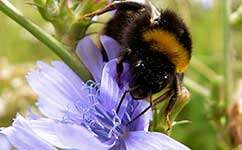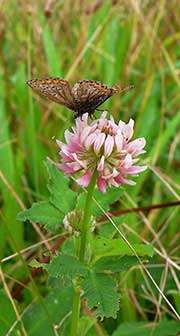Planting a variety of flowers on farmland could boost the number and diversity of pollinating insects, according to new research.
The paper, published in the journal Biological Conservation, says the vital bugs would also benefit from a summer rest period, where fields are left to grow without cutting or grazing.
The research was commissioned by Defra and Natural England with the aim of identifying the value of mixed flowers in farm subsidy schemes.
'Grasslands are really important to pollinators, and they cover around 40 per cent of the UK's land surface,' says Dr Ben Woodcock, from NERC's Centre for Ecology & Hydrology, who led the study.
'But over the past 60 years or so, they've been seriously degraded and now only one or two per cent of that can be considered high-quality habitat for pollinators.'
'Grassland restoration, where we try and re-establish ancient grassland types, is expensive, and so can only be used in a limited number of cases. On the other hand, the most popular grassland agri-environment schemes often fail to establish flowering plants that are so important for bees.'
'What this study shows is that we need a mix of flowers. The flowers of agricultural plants like red clover and other legumes tend to flower quite quickly and then die off. So you need a diverse seed mixture that can maintain flower resources right through the season, and persist for a number of years.'
The team planted three different seed mixtures on a site in Berkshire, UK. The first was made up only of grasses, while the second included a simple mix of agricultural legume flowers, like red clover and birdsfoot trefoil. The third contained a more diverse mix of flower seeds.
They monitored the fields over four years, charting the health of the flowers and the abundance of foraging insects like bees, butterflies and hoverflies. Altogether, they counted more than 8,500 bugs.
As expected, analysis revealed a direct relationship between the abundance of flowers and the number and variety of pollinators.
But only the most complex seed mixture was able to maintain those gains over a number of years. And both flowers and bugs also seemed to benefit from a summer break from cutting and grazing.
Nearly 60 per cent of England's agricultural land is managed under entry-level agri-environment schemes. Under the schemes, farmers receive subsidies to manage their fields in ways that benefit the environment.
The amount of subsidy each farmer gets is based on a points system. In the UK, Defra and Natural England are responsible for deciding how many points are allocated to different management practices.
In recent years, strong support for planting wildflowers in field margins has seen a proliferation of the practice throughout the British countryside, bringing a number of benefits to wildlife. Woodcock and his colleagues would now like to see a similar thing happen on grasslands.
'It would be pretty simple and relatively cheap to implement, and it can make a massive difference to pollinators,' says Woodcock.
'We are doing some work now looking at the range of benefits that these more complex flower mixtures can bring to both the farmer and wider society,' he adds.
The preliminary results of the study, which is published in the journal Biological Conservation, were used to design a new agri-environment scheme option which was made available to farmers in January 2013.
More information: Woodcock BA, Savage J, Bullock JM, Nowakowski M, Orr R, Tallowin JRB, Pywell RF, 'Enhancing floral resources for pollinators in productive agricultural grasslands,' Biological Conservation, 2014
Journal information: Biological Conservation
Provided by PlanetEarth Online
This story is republished courtesy of Planet Earth online, a free, companion website to the award-winning magazine Planet Earth published and funded by the Natural Environment Research Council (NERC).

























